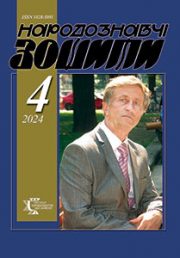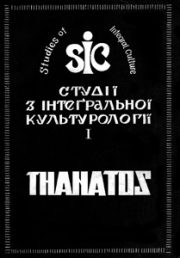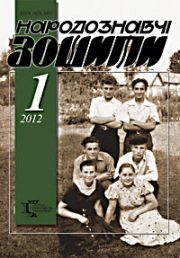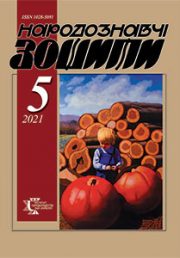The Ethnology Notebooks. 2018, 3 (141), 642–650
UDK 7. 046; 7.041.6
DOI https://doi.org/10.15407/nz2018.03.642
Kosiv Roksolana Romanivna, Ph.D. in Art Studies, Associate Professor
of the Department of Sacral Art of the Lviv National Academy of Arts,
Senior Researcher of the Department of Old-Ukrainian Art
of the National Museum in Lviv named after Andrey Sheptytsky.
Kubiiovycha Street 38, 79011, Lviv, Ukraine.
Contacts: e-mail: lanakosiv@yahoo.com
Abstrakt. The article is devoted to the work of the author of the icons of the apostles from the Order of the Prayer of the iconostasis from the Church of the Nativity of the Virgin in the village of Hrosova in the Western Boikivshchyna (Poland), which is kept at the Museum of Folk Architecture in Sianok. On the basis of the study of the author’s handwriting of the master, it was discovered that the icons from the prophetic tier of this iconostasis and the icon of the Last Supper — from the feast are also associated with it. It is revealed that three cartouches from the prophetic tier of this iconostasis are stored in the Historical Museum in Sianok (they do not have a known place of origin in the museum documentation). The author of the icons of the Apostles from Hrozova is attributed a number of monuments from various museum collections. It is established that the time of creative work of a painter falls on the 1720—1730’s.
Keywords: Icon, Order of Prayer, Ribotsky painting center, Church of the Nativity of the Virgin in the village. Hrozova (Western Boikivshchyna, Poland), author’s manner of painting, stylistics.
Received 21.01.2018
References
Helytovych, M. (2005). Bohorodytsia z Dytiam i pokhvaloiu. Ikony kolektsii Natsionalnoho muzeiu u Lvovi. Lviv: Svichado [in Ukrainian].
Otkovych, Myroslav, Turetskyi, Volodymyr, Kubiv, Stepan. (eds. avtory proektu). (2005). Ikonostas tserkvy Vozdvyzhennia Chesnoho Khresta monastyria Skyt Maniavskyi. Albom — kataloh. Lviv: Naukove vydannia Lvivskoho filialu Natsionalnoho naukovo-doslidnoho restavratsiinoho tsentru Ukrainy [in Ukrainian].
Kosiv, R. (2017). Tvory Tymoteia — maliara, mishchanyna rybotytskoho 1660—1670-ti rr. Narodoznavchi zoshyty. 5, 1149—1155 [in Ukrainian].
Kosiv, R. (2014). Tvory maistra ikon z tserkvy u Limnii ta maistra Trymorfonu z tserkvy u Zdvyzheni v konteksti diialnosti rybotytskoho maliarskoho oseredku pershoi polovyny XVIII st. Litopys Natsionalnoho muzeiu u Lvovi imeni Andreia Sheptytskoho, 10, 88—98 [in Ukrainian].
Ukrainskyi serednovichnyi zhyvopys. Albom. (1976). Kyiv: Mystetstvo; SIX [in Ukrainian].
Chlenova, L. (ed. upor.). Shedevry ukrainskoho ikonopysu XII—XIX st. Albom. (1999). Kyiv: Mystetstvo [in Ukrainian].
Ikona Karpacka. Album wystawy w Parku Etnograficznym w Sanoku. (1998). Sanok [in Polish].
Kinga Jara, R. (2008). Sztuka w służbie Boskiej idei. Zagadnienia artystyczno-ideowe zbiorów sztuki Muzeum budownictwa ludowego w Sanoku na przykładzie kultowego żydowskiego rzemiosła artystycznego i malowideł ściennych cerkwi z Grąziowej. Materiały Muzeum budownictwa ludowego w Sanoku, 37, 173—245 [in Polish].
Kruk, M. (2000). Zachodnioruskie ikony Matki Boskiej z Dzieciątkiem w wieku XV i XVI. Kraków: Wydawnictwo Uniwersytetu Jagiellońskiego [in Polish].







